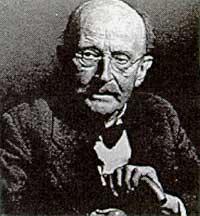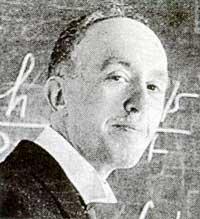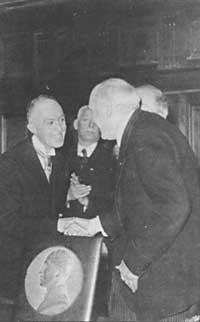One hundred years since the birth of What: zorionak, Planck
2000/12/01 Roa Zubia, Guillermo - Elhuyar Zientzia Iturria: Elhuyar aldizkaria
In today's society, quantum physics has often been added the words "difficult" and "boring." But for those of us who like physics, the succession of events of that time is exciting. XIX. In the last decade of the twentieth century and in the first thirty-five years of the twentieth century (to somehow limit) there was a huge and sudden development of physics.
To analyze the history of quantum discovery, one must first look back. In 1801 the English physicist Thomas Young wanted to better understand what light is. Until then, said by Newton, most thought that light was formed by small particles. But Young made light pass through two slits and saw that it was deframed as floating waves. So Young concluded that light is the wave. Theory of Young XIX. It dominated the nineteenth century. We now know that both Newton and Young were right.
Max Planck
XIX. At the end of the twentieth century physics was very advanced. In fact, experiments were made that Newton's theories did not explain. X-rays (William Konrad Roetgen, 1895) and radiation (Antoine Henry Becquerel, 1896) were recently discovered. Marie Curie, with her husband, discovered thorium and polonium. European scientists were in a concern. In those years, the "radiation of the black body", defined by the Prussian physicist Gustav Robert Kirchhoff, became a puzzle of physicists. The black body is an ideal solid that does not reflect radiation (or light). It absorbs everything that comes to it. If this solid is heated, it emits temperature-dependent radiation. So do the pieces of steel, for example. At a certain temperature, the body emits red light. Somewhat warmer, yellow light. More heating, bluish light, etc. By increasing the temperature, the wavelength of the emitted radiation is lower. However, there is no color mix.Why?
Max Planck was a scientific expert. He received a doctorate at the age of twenty-one (the same year Albert Einstein was born). Despite being a student of Kirchhoff, he took as reference the writings of Rudolf Claussius. In the theories of thermodynamics he was dressed and tried to explain the radiation of the black body. In October 1900 he was very confused. The physics known until then offered no explanations. Almost desperate, she proposed a curious idea that she published on December 14. In this writing he published the formula that joined the energy of a radiation with wavelength. Electromagnetic radiation (light, for example) was formed by exact energy particles. Planck called the quito a unit of radiation and proposed that energy can be absorbed or emitted in whole amounts of quantum. His theory involved excessive innovation and was not immediately approved.
Planck: the look of tragedy
Physicist Max Planck, Nobel Prize in 1918, had a sad life. After twenty-two years married, his wife Marie Merck died in 1909 and the following year married Marga von Hoesslin. A son, Karl, died in Verdun during World War I. Two other daughters, Margarete and Emma, died in childbirth. The Second World War was a very bad time for her. A son was run over and killed for participating in an attack on Hitler. In 1944 Planck's house was completely destroyed by a bombing. After the war, the Americans took her to Gottingen. He died in 1947.
Albert Einstein
When the concept of how young Albert Einstein was born he could not access the job at the ETH (Eidgenossiche Technische Hochschule) in Zurich. In 1902 the father of a friend gave him the opportunity to work in the patent office. He began working for seven years, but had the opportunity to study doctoral studies in free time.
The Nobel Prize in Physics of 1905 was awarded to the German physicist Philipp Lenard. Lenard's observations were very interesting. When the rays of light affect the surface of a metal, they trigger electrons. This phenomenon is called photoelectric effect. It was very curious. Electrons produced by blue light, for example, moved faster than those produced by red light. In addition, in atoms containing electrons related to weak interactions (for example, in cesium), almost any type of light produces a leap. However, the strongest electrons, such as cobalt, cannot be extracted by the red light.
Precisely the same year, Einstein explained the photoelectric effect. For this, it had to be based on the theory of the few. The blue light has a wavelength less than the red and therefore, according to Planck's theory, a much higher energy. In fact, strongly united electrons cannot be released by radiations of great wavelength. They need a lot of energy. More importantly: According to Einstein's hypothesis, photons (components of light) are both particles and waves. In the photoelectric effect, for example, they act as colliding particles, but in Young's experiment they have a marked ondulatory character. It took about ten years until physicists accepted these conclusions.
The work of this amazing scientist did not end there that year. In addition to explaining the photoelectric effect, in 1905 Einstein published his particular theory of relativity. These works were doctoral works. In addition, it should be noted that he was awarded the Nobel Prize in Physics of 1921, but not for the theory of relativity, but for the explanation of the photoelectric effect. Paradoxically, but next to the physical meaning, an anecdote.
This work was the basis of the new branch developed thanks to the theory of what, quantum physics. Einstein's contribution is taken as the true starting point of quantum physics, as Planck represented a unique concept of how much. Later, from the works of Planck and Einstein, many other physicists gave a crazy interpretation to quantum physics, scary to Planck and Einstein. And it is that the last gave his whole life looking for errors in this interpretation.
Niels Bohr
The most prominent name of those who gave a new orientation to quantum theory is Niels Bohr. The contribution of the Danish physicist also shook chemistry. He applied the theory applied to radiation to atoms. He believes that the electrons of atoms could not have any energy. Around the core several concrete orbits were moving, each of them with a determined energy level. Bohr applied the planetary model to the atom. Consequently, the closer the core electron is, the more energy is needed to evacuate it.
It was discovered that the theory is applicable to all particles of the atom. This had terrible consequences: Maxwell's electromagnetism formulas and Newton's classical mechanics were not applicable to systems of this size. Louis de Broglie's theories extended the simultaneous character of particles and waves from photons to electrons. In 1927 Clinton Davisson's experiments confirmed this idea. By the hand of Bohr and Broglie, quantification was applied to matter and not only to light. The limit of what can be understood from our macroscopic level was exceeded.
However, the Bohr model only showed atoms of a single electron. Those who needed another theoretical impulse. Bohr himself believed that he found a general interpretation of quantum physics. It is known as Copenhagen's interpretation and was a success in later physics. In the coming years a huge job was carried out and the contributions of many other physicists improved the model. For example, in the mid-1920s physicists Erwin Schrodinger and Werner Heisenberg maintained Broglie's theory and developed quantum mechanics.
The new mechanics were based on probabilities analysis. Einstein and Planck were completely frightened. All these young physicists began to use the mechanics of waves as crazy and their consequences were very difficult to assume.
In fact, the two inventors of what they never accepted. Heisenberg deduced that, according to the principle of uncertainty, electrons (and all other particles) cannot have one position and one speed at a time. In fact, the orbits initially proposed by Bohr were discarded and the orbitals began to be discussed, that is, the areas of high probability of finding the electron. In other words, the behavior of an electron cannot be predicted until the experiment occurs. Two electrons will not have the same behavior, although they experience the same conditions. On the contrary, the behavior of the sets of electrons conforms to the calculable probability. Einstein never believed it. "God," he said, "does not play in dice."
How much for house
The new atomic model allowed to explain the chemistry experiments. Quantum theory is philosophically very malignant, but in the last sixty years no experiments have been known against what theory announced. In addition, applications that changed the lives of ordinary people were developed immediately.
Perhaps the most important was the transistor invented in 1947 at Bell laboratories (the same year Planck died). This device, made up of layers of semiconductors, can control and amplify the electric current. John Bardeen, Walter H. It was invented by American physicists Brattain and William Shockley. For this invention he received the Nobel Prize in Physics in 1956. (Barde also received a second Nobel Prize in 1972 for his research on superconductivity.) Transistors are the basis of electronics and, therefore, of computing.
But quantum theory has given other outstanding applications. The tunnel effect microscope, for example, offers us the possibility of seeing and manipulating atoms through a famous quantum phenomenon (tunnel effect) (see Elhuyar Zientzia eta Teknika, November 2000 issue, 32 pp. ). This device is a basic working tool for the creation of a nanotechnology that will soon be habitual. On the other hand, we must not forget that the physical principle of lasers is a mere quantum mechanics.

Gai honi buruzko eduki gehiago
Elhuyarrek garatutako teknologia






